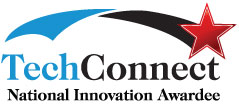TECHNOLOGY SUMMARY
A microwave induced plasma based on a microstrip split-ring resonator (MSRR) operating at atmospheric pressure. Devices are fabricated on commercially available 2.5 mm thick dielectric substrates with 9 µm thick copper coating on both faces. One face is machined or etched to generate a ring-shaped pattern and the other face is used as a ground plane. When microwave power is coupled into the split-ring resonator, the plasma is ignited in the gap region of the split ring. The plasma can be sustained with as little as 0.2W power input and 20-30V making it safe, long-lived and efficient. The design is resistant to electrode erosion, sputtering or chemical damage. To avoid contamination of the signal or electrodes, a layer of glass or other insulator can be placed between the electrodes and the plasma. The technology is simple, easily scalable and miniaturizable at low cost. Four potential application for such MSRR plasma devices are as follows: (1) use as an excitation device for a portable Optical Emission Spectrometer, (2) use an ionization source for portable Liquid Chromatography Mass Spectrometers, (3) as a source for plasma medicine and (4) as a source for sterilization of contaminated surfaces.
AREA/MATURITY/AWARDS
Primary Application Area: Manufacturing, Instrumentation
Technology Development Status: Prototype
Technology Readiness Level: TRL 3
Vetted Programs/Awards: STTR
SHOWCASE SUMMARY
Organization Type: Academic/Gov Lab

Showcase Booth #: 40M
Website: http://www.tufts.edu
GOVT/EXTERNAL FUNDING SOURCES
External Funding to Date: Agilent, Schlumberger, PSI Corp